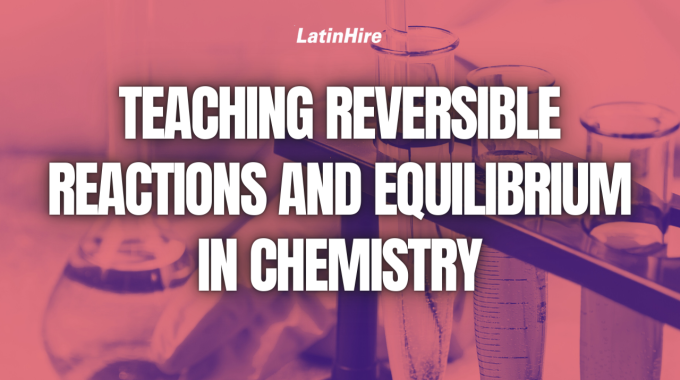Hydrocarbons form the backbone of organic chemistry, and understanding how to name and draw them…

Teaching Reversible Reactions and Equilibrium in Chemistry
For most of a student’s chemistry education journey, chemical reactions are seen as only proceeding in one direction. However, as students advance to higher levels of chemistry, they are introduced to the concept of reversible reactions, which presents a new level of complexity.
Not only do reactants form products, but the reaction can go in reverse where the products form reactants. The forward and reverse reactions participate in a delicate dance until equilibrium is reached. Here is where the rates of the opposing reactions are equal, resulting in no net change in the concentration of the reactants and products over time.
Teaching the concept of reversible reactions and equilibrium requires breaking it down into manageable parts, and providing relatable examples and analogies.
In this article, we’ll explore strategies for unraveling reversible reactions and equilibrium for your chemistry classes, whether in-person or online. We’ll include the main concepts to introduce, while offering real-world examples and activities to help your students understand the fundamental principles.
Characteristics of a Chemical Equilibrium

There are four major characteristics of a reversible reaction in equilibrium:
1) Forward and Reverse Reaction Rates Remain the Same: A major misconception students have about reversible reactions is that once a reaction reaches equilibrium, the reaction stops. This is simply not true, as a chemical equilibrium is dynamic, meaning both the forward and reverse reaction continue, however just at the same rate. While it may appear that nothing is happening on a macroscopic level, there is constant movement and interaction between reactant and product molecules.
2) Constant Concentrations of Reactants and Products: At equilibrium, the concentrations of reactants and products remain constant over time. This does not mean that the concentrations are equal; rather, the ratio of concentrations, known as the equilibrium constant, remains unchanged under a given set of conditions.
3) Macroscopic Properties Remain Constant: Properties such as color, pH, pressure, state of matter, density, etc. should be the same at equilibrium. Any changes in these properties can indicate a shift in the equilibrium.
4) A Catalyst Doesn’t Affect the Equilibrium: Catalysts are used to speed up reactions, however they do not participate in the reaction themselves. They speed up both the forward and the reverse reactions by providing alternative pathways that lower activation energy. Adding a catalyst doesn’t change the equilibrium value, it just helps the reaction reach equilibrium a lot faster.
Real-World Examples of Equilibrium

Equilibrium reactions are observed in numerous natural systems around us. Exploring real-world examples can provide students with tangible connections to the abstract concept of chemical equilibrium.
1) Atmospheric Equilibrium: The atmosphere is a complex system where various chemical reactions reach equilibrium. Take the example of carbon dioxide (CO2) dissolved in the oceans and CO2 in the atmosphere. As atmospheric CO2 levels rise due to human activities, such as burning fossil fuels, more CO2 dissolves into the oceans, establishing an equilibrium that helps buffer the increase in atmospheric CO2 concentrations.
2) Buffer Systems: Biological systems, such as blood, rely on equilibrium principles to maintain pH balance. The blood pH has to remain around 7.45 for various physiological functions to work throughout the body. The blood’s pH buffer system relies on the equilibrium between carbonic acid (H2CO3) and bicarbonate ion (HCO3-) to keep the blood’s pH stable.
3) Haber Process: Industrial synthesis of ammonia (NH3) via the Haber process involves a reversible reaction between nitrogen (N2) and hydrogen (H2) gasses. The system reaches equilibrium, where the rates of ammonia formation and decomposition are equal. The Haber process is a crucial example of how equilibrium principles are applied in large-scale chemical production.
Activity: Analogies of Equilibrium and their Shortcomings

Present the following scenarios to your students and have them discuss whether they are good analogies for equilibrium. Analyze the similarities and differences and discuss them as a class.
1) Tug of War: Imagine a tug of war between two equally strong teams and visualize one team as the reactants and the other as the products.
Potential points to discuss:
- The teams may go back and forth for a while, but because they are evenly matched, so likely neither team is winning.
- Once both teams are no longer moving, is equilibrium reached?
- Shortcoming: In a chemical equilibrium, the forward and reverse reactions are still proceeding, but in the tug of war, the teams will be static.
2) Balanced Scales: Picture a scale with weights on both sides. Initially, one side might be heavier, causing the scale to tip, what can be done to balance the scale?
Potential points to discuss:
- Weights can be added or removed from either side until both sides are balanced, at which point equilibrium is reached.
- Similar to a chemical equilibrium, the rates of the forward and reverse reactions adjust until the concentrations of reactants and products stabilize.
- Shortcoming: When the scale is balanced, there is no more movement of the weights, which fails to demonstrate the dynamic nature of chemical equilibrium.
We hope this article is helpful for your future chemistry classes when you teach the concept of equilibrium! In a future article, we’ll cover Le Chatelier’s principle to analyze how equilibrium systems respond to changes in temperature, pressure, or concentration. Stay tuned!



